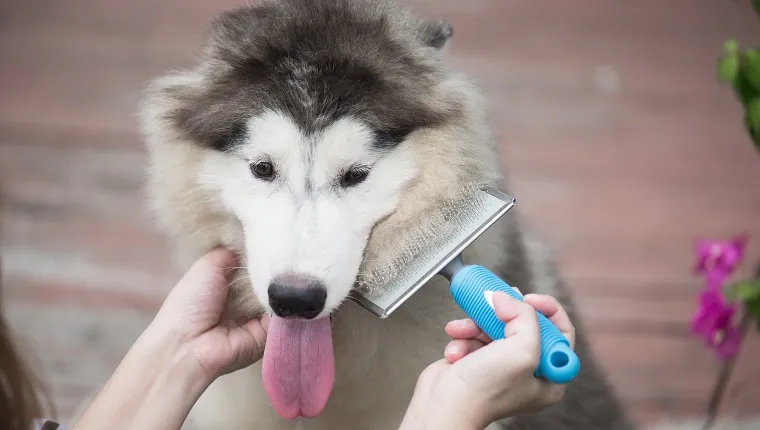What is the difference between dogs fur & hair?
Table Of Content

Breeds that shed less or have a coat that retains loose or dead hairs are an allergy sufferers best bet. Kerry Blue Terriers, Schnauzers, Bichons and Lhasa Apsos all fit this category. These dogs also have less water resistant oils on their skin than other sporting breeds. Is knowing whether your pet has dog hair or dog fur important to you? Many believe that determining whether a dog has fur or hair tells them whether the dog will cause allergic reactions. There are also those who take great pride in the fact that their dog has hair, not fur, claiming they don't shed and are hypoallergenic.
How Do You Tell if a Dog Has Hair or Fur?
Dogs with fur have coats that grow to a predetermined length and then stop growing. Dogs with hair will have coats that grow for much longer—sometimes even for years. Dogs with hair should be brushed regularly to dislodge trapped material and prevent matting.
Do Cats and Dogs Have Fur or Hair?
These dogs have a thick double coat of fur that looks super cuddly but is super essential — to keep your Mal warm. Newfoundlands have a heavy, medium-length double coat and are moderate shedders. However, during spring and fall, you’ll notice an increase. You should brush your Newf with a slicker brush at least once a week, this will help to prevent knots from forming in their fur. Here are a quintet of doggies with fur coats — while they make wonderful canine companions, they’re also heavy shedders.
Poodle Mixes That Don't Shed
However, the company stopped operating under the Allerca domain in 2015. Some breeds of cats are considered low allergy because they do not produce enough Fel d 1 protein to be considered allergenic. Genetics holds the key to a dog’s coat characteristics, dictating factors such as color, texture, length, thickness, and wave or curl patterns if present.
The reality is that both fur and hair are chemically indistinguishable. They are both made up of keratin, the chemical that also creates skin and nails. Technically this means that whether a dog has hair or fur, it's not the reason they may appear to be hypoallergenic.
The Ultimate Guide to Dog Breeds with Hair (NOT Fur)
This is because of the fluffy undercoat of the double-coated breeds. There is no difference between dog hair and fur, and the terms can be used interchangeably. However, you might hear the two terms being used to distinguish between single-coat and double-coat breeds. In contrast to a single-coat breed, a double-coated breed’s coat consists of two layers. These are the dense, fluffy undercoat and the harsher, coarser topcoat. The two layers work together to repel moisture, manage your dog’s body temperature, and protect your pup’s skin from damaging UV rays.
Nomenclature of colours and patterns
Dog fur is allergic because it is denser in undercoat and contains more allergens than hair. Allergies are caused by an overreaction of the immune system to a particular substance. The main source of allergic reactivity stems from a pet\’s saliva.
Vacuums For Pet Hair 2024 - Forbes Vetted - Forbes
Vacuums For Pet Hair 2024 - Forbes Vetted.
Posted: Fri, 22 Mar 2024 07:00:00 GMT [source]
Dog Hair vs Fur: Difference and Comparison
This is where the hair grows to its genetically determined length. In this stage, the hair growth stops and the outer root shrinks, attaching to the root of the new hair. During this stage, the hair follicle is at rest and the hair’s formation is complete.
Do Dogs With Fur or Dogs With Hair Shed More?
However, breeds with hair need regular trimming because of the longer growth. If you get a dog clipper for your home, you can do this task at home, but you can also take your pup to a professional groomer. No dog breed is completely hypoallergenic, no matter which type of coat it has. If we examine the texture of the two coat types, we can also find differences. Hair is generally smoother and finer, but it can be varied in shape. The type of coat your dog has doesn't affect their nutritional needs.
Over-bathing can strip away essential oils, leading to dry, itchy skin and dull fur. Visit a veterinarian promptly if you notice skin problems such as excessive scratching, bald patches, or unusual odors. These could indicate underlying medical conditions requiring professional attention. BREEDING BUSINESS is a platform dedicated to ethical dog breeding around the world.
A dog with a curly coat has hair that grows in tight, spiral curls. This type of coat is often found on breeds, such as the Bichon Frise, Poodle, and Maltese. Curly-coated dogs typically don't shed very much, but they do require regular grooming to prevent their hair from matting. The breed of a dog plays a significant role in determining the type and characteristics of its coat. For instance, Huskies possess thick double coats to withstand frigid Arctic conditions, while Vizslas have short, single coats suitable for warmer climates.
However, while there are a few hairless breeds, like the American Hairless Terrier and the Xoloitzcuintli, the majority of dogs either have a coat made up of fur or hair. Fur dogs also need regular grooming, but the length of their hair isn’t the main concern. Dogs with fur often have a double coat and are likely to be frequent shedders. Dog fur typically has a softer and more fluffy texture than hair.
As well as this, single-coated dogs are often easier to groom and easier to trim with dog clippers. Single-coated dog breeds may struggle to keep warm in a colder climate. As well as this, long-haired single-coated dogs are prone to matting when dead hairs get caught in the coat.
Comments
Post a Comment